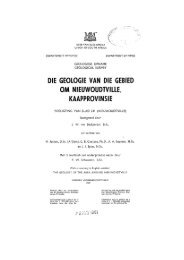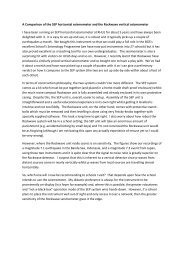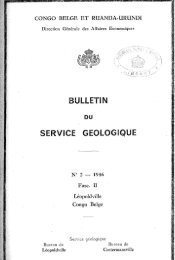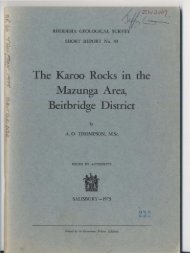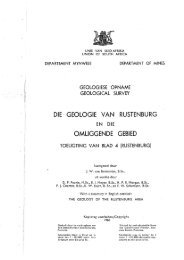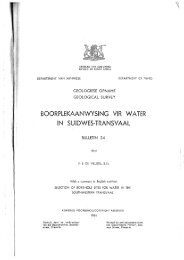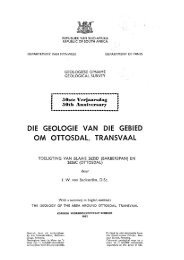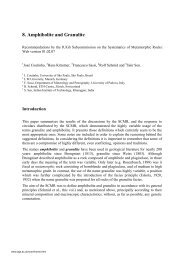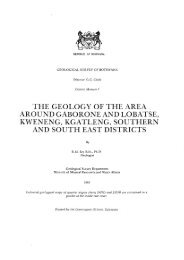Bibliography - British Geological Survey
Bibliography - British Geological Survey
Bibliography - British Geological Survey
Create successful ePaper yourself
Turn your PDF publications into a flip-book with our unique Google optimized e-Paper software.
as old as the gravel bed, some of the elements apparently derived from a still older deposit.’ The author<br />
considers that, viewed independently, the Piltdown jaw and skull are clearly unrelated. Thus, ‘in place of<br />
Eoanthropus dawsoni we have two individuals belonging to different genera, namely: (1) Homo dawsoni,<br />
and (2) Troglodytes dawsoni as suggested by Boule, or Pan vetus, sp. nov., if we adopt Miller’s nomenclature.’)<br />
MacCurdy, G. G. 1924. Human origins: a manual of prehistory. Volume 1. The Old Stone Age and the dawn<br />
of man and his arts. New York & London: D. Appleton and Co, xxxviii, 440 pp. (Piltdown Man, pp. 305,<br />
323–340, 435. Emphasises the lack of harmony between the jaw and skull, which is further obscured in the<br />
former by the missing articular condyle and the incompleteness of the chin region. In spite of recent <strong>British</strong><br />
assertions that the jaw demonstrates hitherto overlooked human features, the validity of Eoanthropus as a<br />
genus is considered to be still unproven.)<br />
Marks, J. 1988. [Book review: The Piltdown Inquest, by Charles Blinderman]. Journal of Human<br />
Evolution, 17, 799–801.<br />
Marks, J. 1992. [Book review:] Piltdown: A Scientific Forgery [&] The Piltdown Papers, by Frank Spencer.<br />
American Journal of Physical Anthropology, 87, 376–380. (The writer does not find the case against Arthur<br />
Keith to be a very convincing one. ‘In Keith’s defense we have the fact that he reconstructed the skull poorly<br />
and then engaged in a protracted and bitter dispute over the proper manner of reconstructing it. If he in fact<br />
perpetrated the fraud himself, it is difficult to imagine him being so absentminded as to have forgotten what<br />
it originally looked like!’ The reviewer asks why so many experts insisted that the jaw belonged to a chimpanzee<br />
and failed to attribute it correctly to an orangutan. Most of these experts had to contend with casts, yet<br />
Hrdlička, who examined the original specimens, saw human characteristics in the jaw! Marks has some<br />
interesting and pertinent things to say about the nature of science, and how scientists act and think. His final<br />
thought is to ask what would have happened if the fraud had been discovered promptly, and the perpetrator<br />
identified: ‘Frankly, I would bet that if the perpetrator of Piltdown had been nailed, s/he would have gotten<br />
off Scotfree, especially if it had been someone prominent such as Arthur Keith (who was already a Scot)...’)<br />
Marks, P. 1987. Skullduggery. New York: Carroll & Graf Publishers, 284 pp. (A novel, based on the<br />
Piltdown forgery, which, to quote Tom Turrittin, ‘depicts fictional accounts of the personal lives of scientists<br />
such as K. P. Oakley and A. S. Woodward, occasionally focusing more on their sexual fantasies and<br />
proclivities than on the subject of Piltdown Man’.)<br />
Marston, A. T. 1936a. Chimpanzee or man? The Piltdown canine tooth and mandible versus the human<br />
specific characteristics of the straight canine and the fused alveolar-maxillo-premaxillary suture. <strong>British</strong><br />
Dental Journal, 61 (June), 216–221.<br />
Marston, A. T. 1936b. Preliminary note on a new fossil human skull from Swanscombe, Kent. Nature, 138<br />
(1 Aug), 200–201. (Comparison with Piltdown)<br />
Marston, A. T. 1936c. Observations on the Piltdown canine tooth. <strong>British</strong> Dental Journal, 61, 595‒569;<br />
see also 728‒729.<br />
Marston, A. T. 1936d. The teeth of prehistoric man. <strong>British</strong> Dental Journal, 61, 595‒569<br />
Marston, A. T. 1937a. The case for the Piltdown jaw. Discovery, 18 (Jan), 13‒15.<br />
Marston, A. T. 1937. The Swanscombe skull. Journal of the Royal Anthropological Institute, 67, 339‒406,<br />
plates XLVI‒LI. (Marston’s formal monograph on this significant find from the 100-foot terrace of the<br />
Thames. Detailed comparisons are made with Piltdown, pp. 386‒404, from which he concludes that the new<br />
fossil is geologically older. Marston had by this time been made aware by K. P. Oakley (p. 394) that the<br />
Piltdown gravel correlates with the much younger 50-foot terrace of the Thames. See Edmunds 1954.)<br />
Marston, A. T. 1946. Piltdown Man: with special reference to the ape mandible and canine tooth.<br />
Geologists’ Association Circular, no. 483, 1. (Abstract of a paper to be read before the Association on<br />
5 July; also cited in Marston 1950b)<br />
Marston, A. T. 1950a. [Comments on the Piltdown canine, molars and mandible.] Abstracts of the<br />
Proceedings of the <strong>Geological</strong> Society of London, no. 1457 (13 Jan), 30‒31. (Report of presentation made<br />
14 Dec 1949, which followed a presentation by K. P. Oakley. Marston showed lantern-slides to illustrate his<br />
attempt to mount a cast of the Piltdown canine into the upper canine socket of a female orang-utan, where it<br />
fitted more comfortably and thus indicated that it belonged to an ape. Radiographs of the canine indicated an



